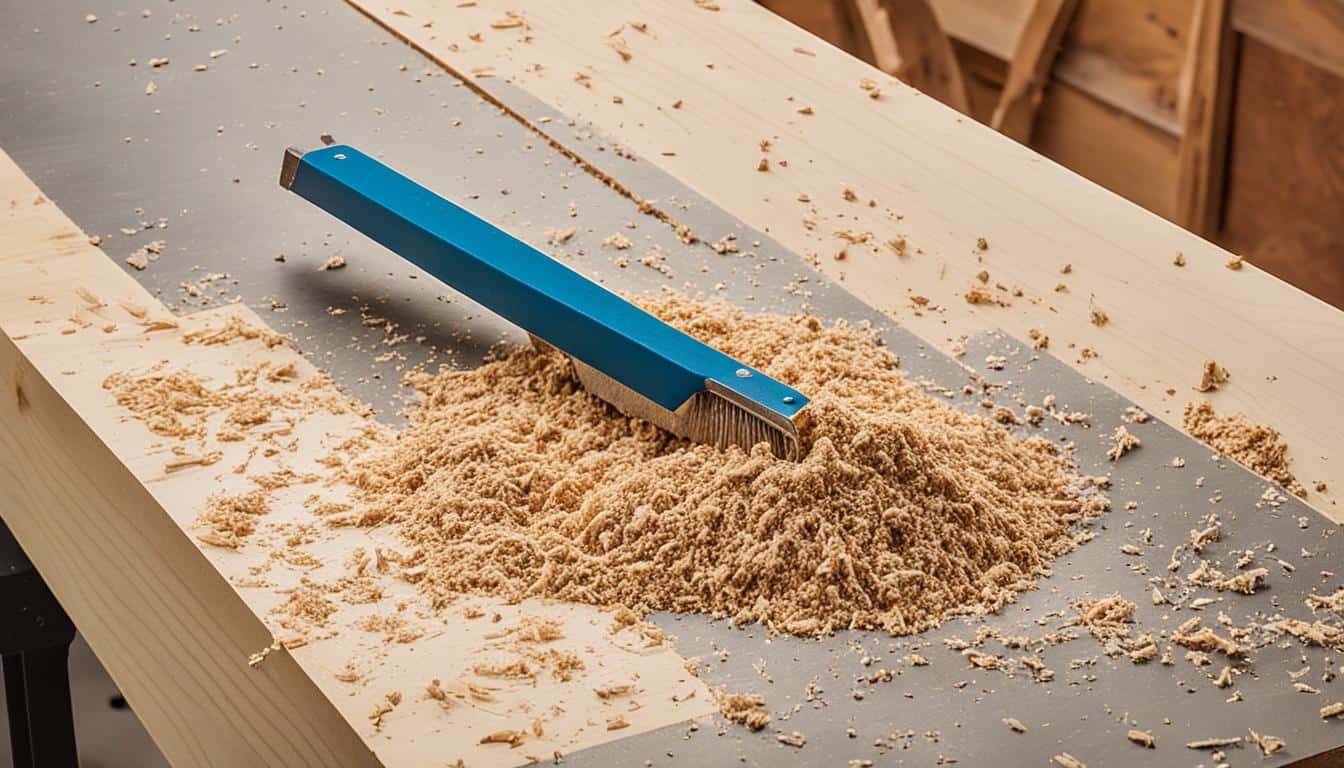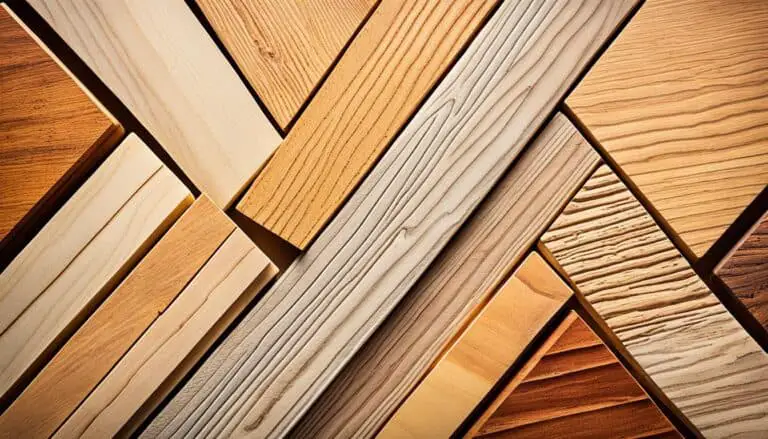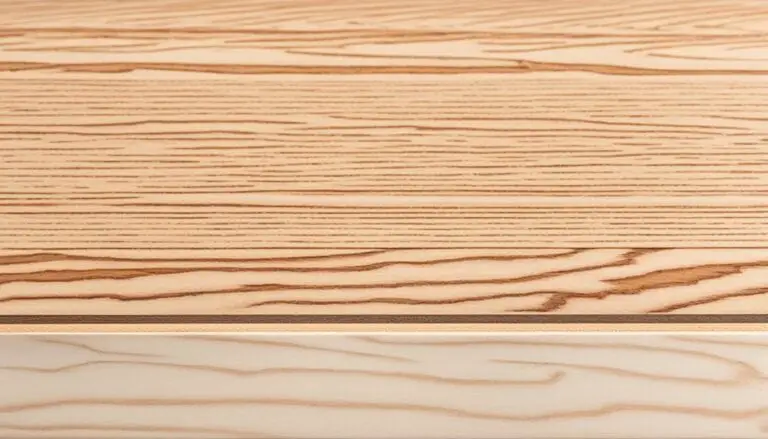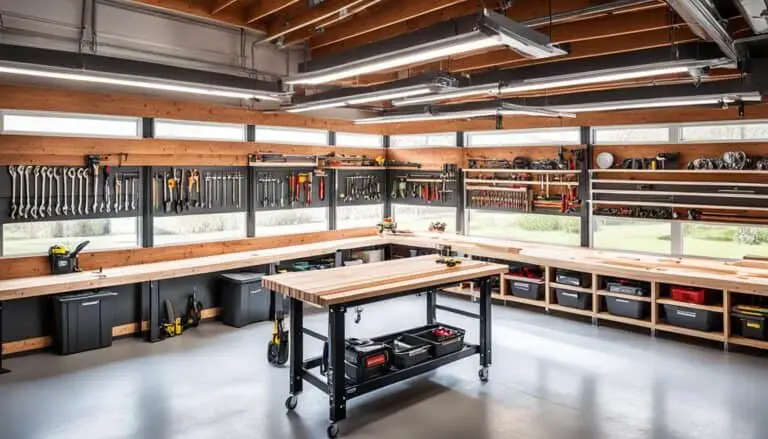Are you looking for a tool that can help you achieve a smooth surface on your woodworking projects? Look no further than a wood scraper. This essential tool offers a faster alternative to sandpaper and is particularly effective on highly figured woods. Whether you’re a beginner or an experienced woodworker, adding a wood scraper to your arsenal of woodworking tools will greatly enhance your craftsmanship.
A wood scraper comes in different types, including hand scrapers, cabinet scrapers, and scraper planes. Each type offers its own advantages, allowing you to choose the tool that best suits your needs. These tools are designed to make your woodworking experience more efficient and comfortable, saving you time and effort in the process.
Key Takeaways:
- A wood scraper is an essential tool for achieving a smooth surface on woodworking projects.
- Hand scrapers are versatile tools that offer better control and faster results compared to sandpaper.
- Cabinet scrapers have a flat sole and are designed to hold the scraper blade at a fixed angle, improving efficiency in smoothing large areas.
- Scraper planes are particularly useful when working with highly figured woods and large surfaces.
- Setting the correct angle is crucial for optimal results when using a wood scraper.
Hand Scrapers for Smoothing Surfaces
Hand scrapers are a valuable tool for achieving a smooth surface on your woodworking projects. These versatile tools consist of a thin, flexible steel blade that can lift fine shavings from the wood surface, resulting in a polished finish. Hand scrapers are particularly useful for removing planer or saw marks, smoothing panels, and flushing out plywood edging.
Compared to sandpaper, hand scrapers offer better control and faster results. They allow you to precisely target specific areas, eliminating imperfections and creating a flawless surface. With a hand scraper, you can achieve a level of smoothness that may be challenging to attain with sandpaper alone.
Advantages of Using Hand Scrapers
- More control: Hand scrapers allow you to apply consistent pressure and work on specific areas, resulting in a smoother surface.
- Faster results: Hand scrapers can remove material more quickly than sandpaper, saving you time and effort.
- Efficient on difficult woods: Highly figured or interlocked woods can be challenging to sand, but hand scrapers excel at smoothing these surfaces.
Whether you’re a beginner or an experienced woodworker, having a hand scraper in your toolkit will enhance your woodworking experience and help you achieve professional-level finishes.
“A hand scraper is an essential tool for achieving a polished, glass-smooth surface on your woodworking projects.” – James Wilson, Woodworking Expert
Using Hand Scrapers: Techniques and Tips
Here are some tips to keep in mind when using hand scrapers:
- Sharpen the blade: Regularly sharpen the hand scraper blade to ensure optimal performance. A sharp blade will produce finer shavings and result in a smoother surface.
- Angle the scraper: Hold the hand scraper at a slight angle to the wood surface, about 20-30 degrees. This angle helps the blade engage with the wood effectively.
- Apply even pressure: Apply consistent, even pressure while scraping. Avoid using excessive force, as it can cause gouges or tearout.
- Practice on scrap wood: If you’re new to using hand scrapers, practice on scrap wood before working on your actual project. This will help you get a feel for the tool and refine your technique.
By mastering the art of using hand scrapers and learning the nuances of the tool, you’ll be able to achieve smooth, professional finishes on your woodworking projects.
Cabinet Scrapers for Efficient Smoothing
When it comes to smoothing surfaces in woodworking, cabinet scrapers are simple yet highly effective tools. These scrapers are designed to make your woodworking experience more efficient and comfortable, allowing you to achieve a smooth finish on your projects with ease.
Cabinet scrapers typically feature a holder for a hand (card) scraper, with wing-style handles and a clamp to hold the scraper blade in place. This design provides stability and control, allowing you to glide the scraper smoothly over the wood surface.
One of the key advantages of cabinet scrapers is their flat sole. Unlike other scraping tools, the flat sole of a cabinet scraper makes it easier to maintain a consistently flat surface while smoothing a workpiece. This is especially important when working on large areas or projects with intricate details.
Another benefit of cabinet scrapers is that they are designed to hold the scraper blade at a fixed angle. This not only reduces fatigue but also improves efficiency in smoothing large areas. With a cabinet scraper, you can achieve consistent results without having to constantly readjust the angle of the blade.
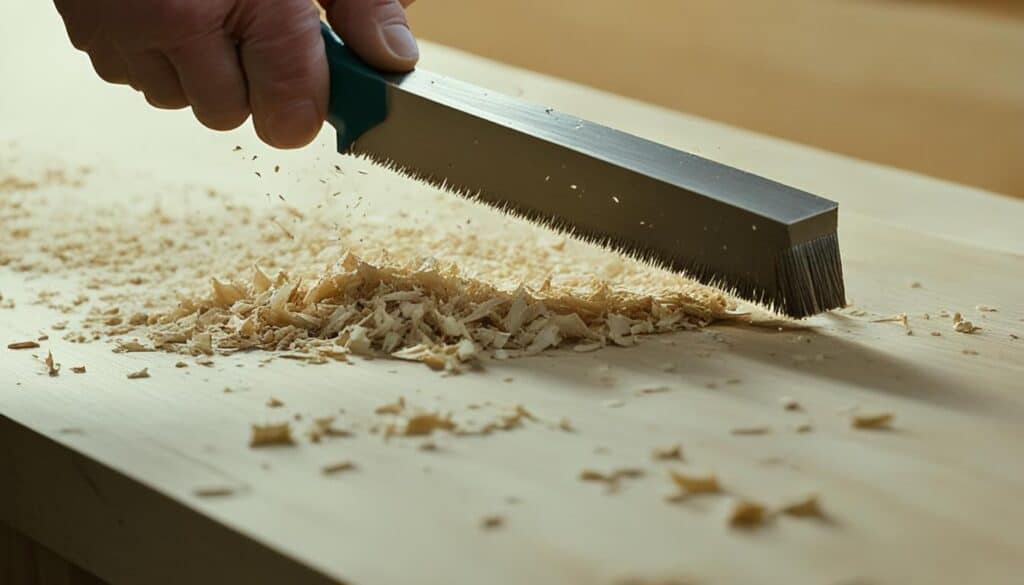
Using a cabinet scraper is straightforward. Hold the handles firmly and apply gentle pressure as you move the scraper across the wood surface. The sharp blade efficiently removes any imperfections, leaving you with a smooth and flawless finish.
When it comes to smoothing large surfaces or achieving a consistent finish, cabinet scrapers are the go-to tools for many woodworkers. Their design and functionality make them highly efficient and reliable, allowing you to take your woodworking projects to the next level.
Whether you’re a beginner or an experienced woodworker, a cabinet scraper is a valuable addition to your woodworking toolkit. Its efficiency, ease of use, and ability to create smooth surfaces make it a must-have tool for any woodworking project.
Key Features of Cabinet Scrapers:
- Holder for hand scraper
- Wing-style handles for stability
- Clamp to secure the scraper blade
- Flat sole for maintaining a consistently flat surface
- Fixed angle for reducing fatigue and improving efficiency
Investing in a quality cabinet scraper will greatly enhance your woodworking experience and help you achieve outstanding results. Take advantage of this versatile tool to create smooth surfaces that will impress even the most discerning eye.
Scraper Planes for Superior Finishing
When it comes to achieving impeccable finishes on your woodworking projects, scraper planes are a game-changer. Unlike traditional plane irons, scraper planes hold a thick scraper blade that excels in smoothing highly figured woods and large surfaces. With their unique design, scraper planes offer precise control and the option to sharpen the blade without the usual burr on the edge.
Say goodbye to the frustration of tearout and hello to flawless results with a scraper plane in your toolkit.
Set the Correct Angle for Optimal Results
When using a scraper plane or hand scraper, setting the correct angle is crucial for achieving optimal results. The cutting angle of the blade is typically between 45° to 60° to vertical, but it can vary depending on the task at hand. The blade should also be held slightly skewed to the direction of the wood grain to avoid creating ridges. Adjusting the angle and paying attention to the thickness of the shavings will help you achieve a glass-smooth surface.
Properly setting the angle of the wood scraper is essential to ensure that you remove material efficiently and achieve smooth results. A common starting point is a cutting angle of around 45 degrees. However, you may need to experiment with different angles to find the sweet spot for the specific wood you’re working with.
When positioning the scraper, keep in mind that holding it slightly skewed to the wood grain helps prevent the formation of ridges. By doing so, you can smoothly and evenly scrape the surface without causing any irregularities.
Remember to regularly check the thickness of the shavings. If they become too thin or start to tear, it may indicate that the angle is incorrect, or the blade needs sharpening. Adjusting the cutting angle and the pressure you apply can greatly impact the quality of results.
By taking the time to set the correct angle and paying attention to the details, you can achieve the desired glass-smooth surface on your woodworking projects.
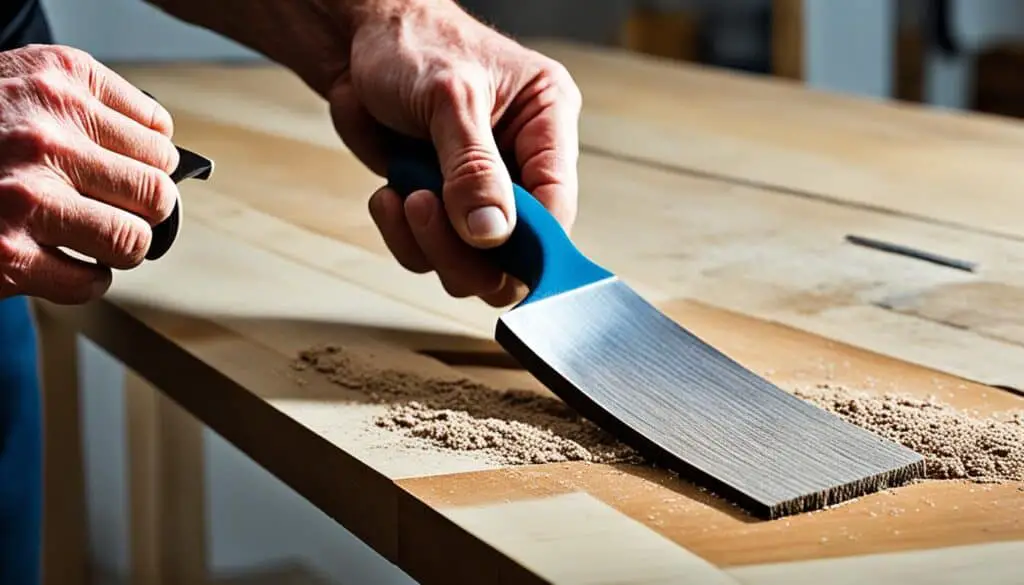
Angle Adjustment Tips:
- Start with a cutting angle of around 45 degrees and adjust as needed.
- Hold the scraper slightly skewed to the direction of the wood grain to avoid ridges.
- Regularly check the thickness of the shavings to ensure optimal results.
The Benefits of Using a Wood Scraper
Using a wood scraper offers several advantages over other smoothing methods like sandpaper. A wood scraper eliminates the risk of tearout and allows for precise control over the smoothing process. It is also a faster alternative to sandpaper, saving you time and effort. Whether you choose a hand scraper, cabinet scraper, or scraper plane, these tools will greatly improve your woodworking experience and help you achieve professional-level finishes.
Woodworking Tools:
- Wood scrapers provide efficient and effective smoothing of wood surfaces.
- They eliminate the risk of tearout, ensuring a smooth and flawless finish.
- With a wood scraper, you have complete control over the smoothing process.
- It allows you to remove imperfections and achieve precise results.
The Benefits at a Glance:
“A wood scraper provides precise control, eliminates tearout, and offers a faster alternative to sandpaper.”
Hand Scraper for Wood:
- A hand scraper is a versatile and portable tool for smoothing workpieces.
- It can quickly remove planer or saw marks, leaving behind a smooth surface.
- Hand scrapers are ideal for flushing out plywood edging and leveling panels.
- They offer better control and faster results compared to sandpaper.
Wood Scraping Tool:
- A wood scraper is a must-have tool for any woodworking project.
- It enables you to achieve professional-level finishes with ease.
- Wood scrapers are suitable for both beginners and experienced woodworkers.
- They provide versatility, efficiency, and control in your woodworking tasks.
Tips for Using a Wood Scraper
To achieve the best results with a wood scraper, there are several tips and techniques to keep in mind. Using a wood scraper is a two-handed job, as the scraper works best when forced into a slight bow. Some woodworkers prefer to push the scraper across the wood, while others find it easier to pull it. The pitch or cutting angle of the blade and the angle of the scraper edge in relation to the grain direction can vary and should be adjusted based on the desired result.
The Versatility of Wood Scrapers
Wood scrapers are versatile tools that can be used for various woodworking tasks. Whether you’re a beginner or an experienced woodworker, a wood scraper is a must-have tool in your workshop. Its flexibility, control, and efficiency make it an invaluable asset for tackling a wide range of woodworking projects.
Removing Planer or Saw Marks
One of the primary applications of a wood scraper is removing planer or saw marks from the surface of the wood. With a wood scraper, you can effortlessly eliminate imperfections and achieve a smooth and flawless finish, preparing the wood for further refinement or finishing.
Smoothing Panels
Wood scrapers excel at smoothing panels, ensuring that they are even and free from any irregularities. Whether you are working on large cabinet doors or smaller drawer fronts, a wood scraper will help you level and smooth the surface, creating a professional and refined appearance.
Flushing Out Plywood Edging
When working with plywood, it is common for the edges to be slightly uneven or protruding. A wood scraper is an excellent tool for flushing out plywood edging, allowing you to achieve a flush and seamless joint. The scraper can help you achieve a consistent edge, ensuring a smooth and professional look.
“Wood scrapers are like chisels for smoothing wood surfaces. They are versatile tools, and using them is a true art form.”
From removing planer or saw marks to smoothing panels and flushing out plywood edging, a wood scraper offers unmatched versatility in woodworking. Its ability to quickly and efficiently level surfaces and create a flawless finish makes it an indispensable tool for any woodworking project.
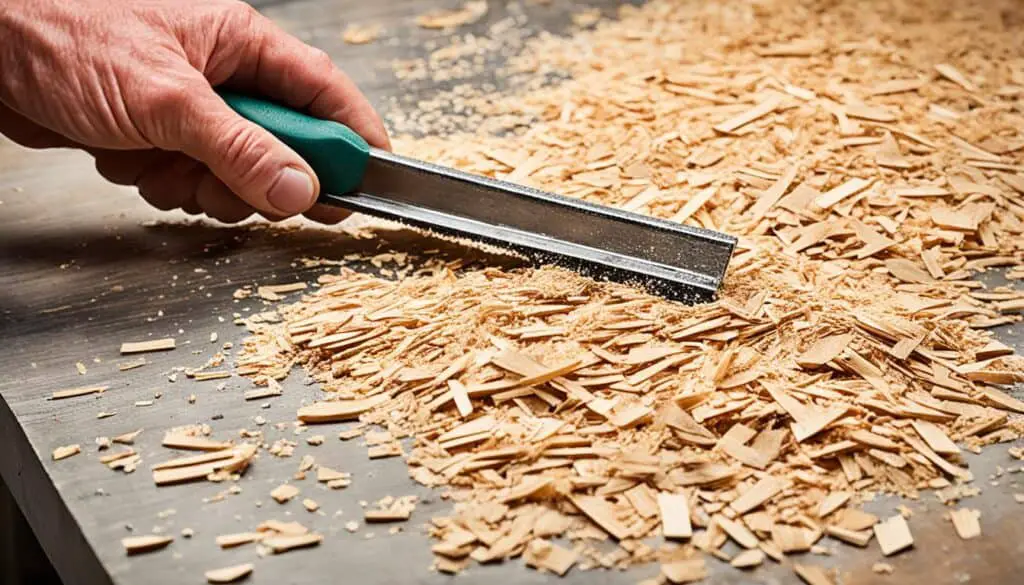
Whether you’re working on furniture, cabinets, or small crafts, a wood scraper will greatly enhance your woodworking skills and enable you to achieve professional-level results. Invest in a high-quality wood scraper and master the techniques of using this versatile tool to take your woodworking projects to the next level.
Achieving a Glass-Smooth Surface with a Wood Scraper
One of the main benefits of using a wood scraper is the ability to achieve a glass-smooth surface on your projects. The sharp blade of a scraper effectively removes any imperfections, leaving behind a flawless finish. Whether you’re preparing a workpiece for staining or applying a protective coat, a wood scraper will ensure a smooth and professional result.
Wood scrapers offer a level of precision and control that is unparalleled by other smoothing methods such as sandpaper. The scraping action of the blade removes thin layers of wood, resulting in a clean surface free from tearout and sanding marks. This makes it an ideal tool for achieving a smooth finish on highly figured woods or challenging grain patterns.
Unlike sandpaper, which can wear down quickly and require frequent replacement, a wood scraper can be sharpened and used repeatedly, making it a cost-effective option in the long run. With proper technique and maintenance, a wood scraper can last for years, providing consistent results on all your woodworking projects.
“The sharp blade of a wood scraper allows for precise removal of imperfections, resulting in a glass-smooth surface.”
To achieve a glass-smooth surface using a wood scraper, it’s important to follow a few key steps:
1. Prepare your workpiece
Before using a wood scraper, ensure that your workpiece is properly prepared. This includes planing or sanding any rough spots and removing any glue residue or debris.
2. Choose the right blade
Select a scraper blade appropriate for the task at hand. Different blades have varying shapes and thicknesses, each suited for specific applications. Ensure that the blade is sharp and properly honed for optimal performance.
3. Hold the scraper correctly
Hold the wood scraper firmly but not too tightly. The scraper should be slightly bowed, allowing the blade to engage with the wood surface. Keep your fingers away from the cutting edge to ensure safety.
4. Angle the scraper
Angle the scraper blade at about 45 degrees to the wood surface. This angle may need adjustment depending on the type of wood and the desired result. Experiment with different angles to find what works best for your specific project.
5. Apply even pressure
Apply consistent and even pressure on the scraper as you move it across the wood surface. Maintain the same pressure throughout the stroke to achieve a uniform finish.
6. Check your progress
Regularly check the surface of the wood to assess your progress. Lightly sand any areas that may require additional smoothing. Repeat the scraping process until you achieve the desired level of smoothness.
By following these steps and practicing good technique, you can consistently achieve a glass-smooth surface using a wood scraper. Experiment with different blades, angles, and pressure to develop your own unique approach to woodworking with a scraper.
With a wood scraper in your toolkit, you’ll have the power to transform any rough wood surface into a polished masterpiece. Enjoy the satisfaction of achieving a flawless finish and take your woodworking projects to the next level.
| Pros | Cons |
|---|---|
| Creates a smooth, tearout-free finish | Requires practice to master the technique |
| Provides precise control over the smoothing process | May not be suitable for curved or irregular surfaces |
| Cost-effective, as the blade can be sharpened and reused | Initial investment in a good quality scraper is required |
| Fast and efficient compared to sanding | Requires periodic sharpening and maintenance |
Mastering the Art of Wood Scraping
While the concept of wood scraping may seem simple, mastering the art requires practice and technique. Experimenting with different angles, pressures, and blade positions will help you find the sweet spot for the best results. By honing your skills and understanding the nuances of using a wood scraper, you can take your woodworking craftsmanship to the next level.
Refining Your Technique
Wood scraping is a skill that improves with practice. Start by selecting the appropriate wood scraper for the task at hand, whether it’s a hand scraper, cabinet scraper, or scraper plane. Familiarize yourself with the tool’s design and functionality before diving into your project.
When using a hand scraper, hold it firmly with both hands. Apply consistent pressure and move the scraper in long, smooth strokes along the wood grain. Experiment with different blade angles to achieve the desired effect.
Cabinet scrapers require a similar technique but offer the advantage of a flat sole for better surface contact. Hold the handles firmly and apply even pressure as you scrape across the wood. Adjust the blade angle and orientation to minimize tearout and achieve a smooth finish.
Scraper planes are ideal for larger surfaces. Hold the handle firmly and push or pull the plane in long, controlled strokes. Adjust the blade position and angle to ensure consistent shaving thickness.
Perfecting the Details
As you become more comfortable with wood scraping, you’ll discover the importance of attention to detail. Here are a few tips to further enhance your wood scraping technique:
- Keep the scraper blade sharp. Regularly hone and sharpen the blade to maintain optimal performance.
- Pay attention to the wood grain. Scrape in the direction of the grain for the best results and to avoid creating ridges.
- Experiment with different pressures. Adjusting the pressure applied to the scraper can yield different effects on the wood surface.
- Use a light touch. Avoid exerting excessive force on the scraper, as this may result in chatter or gouging.
Image of Wood Scraper in Action
Wood Scraper Types and Applications
| Wood Scraper | Applications |
|---|---|
| Hand Scraper | Smoothing planer or saw marks, leveling surfaces, removing old finishes |
| Cabinet Scraper | Flushing out plywood edging, cleaning up joinery, creating chamfers |
| Scraper Plane | Smoothing large surfaces, shaping and leveling highly figured woods |
Mastering the art of wood scraping requires patience, practice, and a genuine passion for woodworking. With time and experience, you’ll develop an intuition for achieving the perfect finish on your projects. Embrace the versatility and control that wood scrapers provide, and elevate your woodworking craftsmanship to new heights.
Wood Scraper Maintenance and Sharpening
To ensure the longevity and effectiveness of your wood scraper, regular maintenance is essential. By keeping the blade sharp and properly aligned, you can optimize its performance for smooth and efficient woodworking. Here are some tips for maintaining and sharpening your wood scraper:
Inspecting Your Wood Scraper
Regularly inspect your wood scraper to identify any signs of wear or damage. Check the blade for any nicks, cracks, or burrs that may affect its performance. Ensure that the blade is securely attached to the handle or holder, without any loose or wobbly parts.
Sharpening Your Wood Scraper
Sharpening a wood scraper involves removing any burrs on the edge and honing the blade to a razor-sharp finish. To do this:
- Secure the wood scraper in a vise or clamp to keep it steady during sharpening.
- Use a mill file or a sharpening stone to remove any burrs or rough edges from the blade. Work in a controlled and consistent motion, applying light pressure to avoid damaging the blade.
- Once the burrs are removed, use a burnisher to create a thin, smooth edge on the blade. Apply firm and even pressure, moving the burnisher along the edge of the scraper in a controlled motion.
- After burnishing, use a felt or leather strop with some polishing compound to further refine the blade’s edge and ensure a smooth finish.
Remember to always follow the manufacturer’s guidelines for sharpening your specific wood scraper model.
Maintaining Your Wood Scraper
In addition to sharpening, regular maintenance of your wood scraper will ensure its reliability and longevity. Here are some maintenance tips:
- After each use, clean the blade to remove any wood particles or debris that may have accumulated. Use a soft brush or cloth to gently wipe away the residue.
- Apply a thin coat of rust-preventive oil to the blade to protect it from corrosion. This is especially important if you live in a humid environment.
- Store your wood scraper in a dry and clean location, away from excessive heat or moisture. Consider using a dedicated toolbox or storage case to keep it protected and organized.
By regularly inspecting, sharpening, and maintaining your wood scraper, you’ll ensure that it remains a reliable and effective tool in your woodworking arsenal. Proper maintenance will not only enhance its performance but also extend its lifespan, allowing you to enjoy smooth and flawless woodworking results for years to come.
| Maintenance Tips | Benefits |
|---|---|
| Inspect your wood scraper regularly | Identify and address any signs of wear or damage |
| Sharpen your wood scraper | Ensure a razor-sharp edge for efficient wood scraping |
| Maintain your wood scraper | Extend its lifespan and optimize its performance |
Wood Scrapers vs. Sandpaper: Pros and Cons
When it comes to smoothing wood surfaces, two popular options are wood scrapers and sandpaper. Each method has its own unique advantages and disadvantages, which you should consider before deciding which tool to use for your woodworking projects.
Wood Scrapers: Advantages
- Eliminates Tearout: One of the key advantages of using a wood scraper is that it eliminates the risk of tearout, where wood fibers are torn away during the smoothing process. This makes it an excellent choice for working with delicate or highly figured woods.
- Better Control: Wood scrapers provide better control compared to sandpaper. The sharp blade of a scraper allows you to precisely remove material and smooth the surface to your desired level of perfection.
- Faster Results: Wood scrapers work faster compared to sandpaper, allowing you to save time and energy. With a few well-executed strokes, you can achieve a smooth surface in less time compared to sanding.
Wood Scrapers: Disadvantages
- Not Ideal for Curved Surfaces: Wood scrapers are not as adaptable to curved or irregular surfaces as sandpaper. Their rigid design makes it difficult to conform to intricate shapes or contours.
- Requires Skill and Practice: Using a wood scraper effectively requires some skill and practice. It may take time to master the technique and achieve consistent results.
Sandpaper: Advantages
- Adaptable to Curved Surfaces: Sandpaper is highly adaptable and can be used on curved or irregular surfaces without much difficulty. This makes it a versatile option for a variety of woodworking projects.
- Wide Range of Grits: Sandpaper offers a wide range of grit options, allowing you to achieve different levels of smoothness and surface preparation. Whether you need fine sandpaper for a final finish or coarse sandpaper for initial material removal, there is a grit available for every need.
- Easy to Use: Sandpaper is readily available and easy to use. Simply wrap it around a sanding block or your fingers and start sanding the wood surface.
Sandpaper: Disadvantages
- Risk of Tearout: Using sandpaper increases the risk of tearout, especially when working with delicate or highly figured woods. The abrasive particles can catch on the wood fibers and tear them away, resulting in a rough and uneven surface.
- Time-Consuming: Sanding with sandpaper can be a time-consuming process, especially when dealing with large surfaces or intricate details. It requires consistent effort and can be physically demanding.
Ultimately, the choice between wood scrapers and sandpaper depends on your specific woodworking needs and preferences. Wood scrapers are excellent for achieving tearout-free, precise, and efficient smoothing, while sandpaper offers adaptability to curved surfaces and a wide range of grit options. Consider these pros and cons to make an informed decision and efficiently complete your woodworking projects.
Note: The image above depicts a wood scraper in action, showcasing its effectiveness in achieving a smooth surface.
Popular Wood Scraping Techniques and Applications
Wood scraping is a versatile technique that can be utilized for various woodworking projects and applications. Understanding different scraping techniques and their respective applications will enable you to maximize the potential of your woodworking tools, such as the scraper for woodworking and wood scraping tool.
Below are some popular wood scraping techniques and their common applications:
1. Smoothing Planer or Saw Marks
When working with rough-surfaced wood, a wood scraper can be used to remove visible planer or saw marks. By gently scraping the surface of the wood, you can achieve a smoother texture and prepare the wood for further finishing.
2. Leveling Surfaces
If you encounter uneven surfaces or slight imperfections in your woodworking project, a wood scraper can help level out those areas. By carefully scraping high spots and grooves, you can create a more uniform and aesthetically pleasing surface.
3. Removing Old Finishes
When refinishing wood furniture or restoring old wooden pieces, a wood scraper is an invaluable tool for removing old finishes, such as varnish or paint. The scraping action helps strip away the layers of finish, allowing you to start with a clean surface.
4. Removing Glue Residue
Wood glue is commonly used in woodworking projects, but excess glue can sometimes seep out and leave behind unsightly residue. A wood scraper is an effective tool for carefully removing this glue residue without damaging the wood surface.
5. Cleaning Up Joinery
Joinery, such as dovetails or mortise-and-tenon joints, often leaves behind excess material or uneven edges. A wood scraper can be used to clean up these joints and create smooth, seamless transitions between the joined pieces.
6. Creating Chamfers
A chamfer is a beveled edge or angled cut that adds visual interest to woodworking projects. A wood scraper can be used to create precise chamfers, whether it’s for decorative purposes or to facilitate easier assembly of wooden components.
Familiarizing yourself with these wood scraping techniques and applications will allow you to unleash the full potential of your woodworking tools. Experimenting with different techniques and honing your skills will enable you to achieve exceptional results in your woodworking projects.
| Technique | Application |
|---|---|
| Smoothing Planer or Saw Marks | Removing visible planer or saw marks for a smoother surface |
| Leveling Surfaces | Evening out uneven areas and imperfections |
| Removing Old Finishes | Stripping away varnish or paint when refinishing |
| Removing Glue Residue | Carefully removing excess wood glue without damaging the surface |
| Cleaning Up Joinery | Creating clean and smooth transitions between joined pieces |
| Creating Chamfers | Adding decorative beveled edges or angled cuts |
Woodworking Finishing Tips with a Wood Scraper
A wood scraper is an invaluable tool for achieving impeccable finishes in woodworking projects. When using a wood scraper for finishing, it’s important to pay attention to detail and take your time. The smooth surface created by a wood scraper provides an excellent foundation for staining, varnishing, or painting. By incorporating a wood scraper into your finishing process, you can achieve professional-level results.
| Woodworking Finishing Tips | |
|---|---|
| 1. Prepare the surface | Before using a wood scraper for finishing, ensure that the surface is properly prepared. This includes sanding any rough areas and removing any dust or debris. |
| 2. Use light pressure | When scraping the surface with a wood scraper, use light pressure. Applying too much pressure may cause the scraper to dig into the wood, resulting in an uneven finish. |
| 3. Sharpen the blade | Regularly sharpen the blade of your wood scraper to maintain its effectiveness. A sharp blade will produce cleaner and smoother results. |
| 4. Work in small sections | To ensure consistent results, work in small sections when using a wood scraper for finishing. This allows you to focus on one area at a time and achieve a uniform finish throughout your project. |
| 5. Remove any burrs | After scraping the surface, carefully remove any burrs or rough edges left by the wood scraper. This can be done by lightly sanding the surface or using a fine file. |
Remember, using a wood scraper for finishing requires patience and attention to detail. Take your time, follow the proper techniques, and enjoy the satisfaction of achieving a smooth and flawless finish on your woodworking projects.
Expert Tip:
“When using a wood scraper for finishing, make sure to maintain a consistent angle and apply even pressure. This will help you achieve a uniform and professional finish on your woodworking projects.” – Mark Woodson, Woodworking Expert
Conclusion
Wood scrapers are indispensable tools for achieving smooth and flawless surfaces in your woodworking projects. Whether you prefer a hand scraper, cabinet scraper, or scraper plane, these woodworking tools offer versatility, efficiency, and precise control that will elevate your craftsmanship. Although mastering the technique of wood scraping requires practice, the professional results are well worth the effort. With a wood scraper in your tool collection, you will have the confidence and precision to tackle any woodworking project.
By using a wood scraper, you can avoid tearout and achieve a glass-smooth finish that enhances the beauty of your work. These tools offer faster alternatives to sandpaper, saving you time and effort in the smoothing process. Whether you’re removing planer or saw marks, smoothing panels, or flushing out plywood edging, a wood scraper is a must-have tool.
With a wide range of applications and the ability to handle various woodworking tasks, wood scrapers are versatile additions to any workshop. They offer better control and faster results compared to sandpaper, making them an essential choice for both beginners and experienced woodworkers. Incorporating a wood scraper into your woodworking routine will significantly enhance your skillset and enable you to achieve professional-level finishes.
FAQ
What is a wood scraper?
A wood scraper is a tool used in woodworking to achieve a smooth surface on projects. It is an alternative to sandpaper and is particularly effective on highly figured woods.
What types of wood scrapers are available?
There are different types of wood scrapers, including hand scrapers, cabinet scrapers, and scraper planes.
What is a hand scraper?
A hand scraper is a versatile tool that can quickly smooth a workpiece in preparation for finishing. It consists of a thin, flexible steel blade that can lift fine shavings from the wood surface.
What is a cabinet scraper?
A cabinet scraper is a tool that features a holder for a hand scraper, with wing-style handles and a clamp to hold the scraper blade in place. It has a flat sole, which makes it easier to maintain a consistently flat surface while smoothing a workpiece.
What is a scraper plane?
A scraper plane is a tool that holds a thick scraper blade instead of a traditional plane iron. It is particularly useful when working with highly figured woods and large surfaces.
How do you set the correct angle when using a wood scraper?
The cutting angle of the blade is typically between 45° to 60° to vertical, but it can vary depending on the task at hand. The blade should also be held slightly skewed to the direction of the wood grain to avoid creating ridges.
What are the advantages of using a wood scraper?
Using a wood scraper eliminates the risk of tearout, provides precise control, and is faster than sandpaper.
What are some tips for using a wood scraper?
When using a wood scraper, it is a two-handed job, as the scraper works best when forced into a slight bow. The angle and pressure of the blade can vary based on the desired result.
How versatile are wood scrapers?
Wood scrapers can be used for a variety of tasks, including removing planer or saw marks, smoothing panels, and flushing out plywood edging.
How can a wood scraper help achieve a glass-smooth surface?
A wood scraper’s sharp blade effectively removes imperfections, creating a flawless finish that is ideal for staining or applying a protective coat.
How can you master the art of wood scraping?
Mastering wood scraping requires practice and technique. Experimenting with different angles, pressures, and blade positions will help you achieve the best results.
How should a wood scraper be maintained and sharpened?
Regular maintenance is necessary for a wood scraper. Keeping the blade sharp and properly aligned ensures optimal performance.
What are the pros and cons of wood scrapers vs. sandpaper?
Wood scrapers eliminate the risk of tearout and provide better control and efficiency. However, sandpaper is more adaptable to curved or irregular surfaces.
What are some popular wood scraping techniques and applications?
Wood scrapers are commonly used for smoothing planer or saw marks, leveling surfaces, removing old finishes, and cleaning up joinery.
What are some woodworking finishing tips with a wood scraper?
A wood scraper provides a smooth surface for finishing. It is an excellent tool for preparing a workpiece for staining, varnishing, or painting.
Are wood scrapers essential tools for woodworking?
Yes, wood scrapers are essential tools for achieving smooth and flawless surfaces on woodworking projects.


